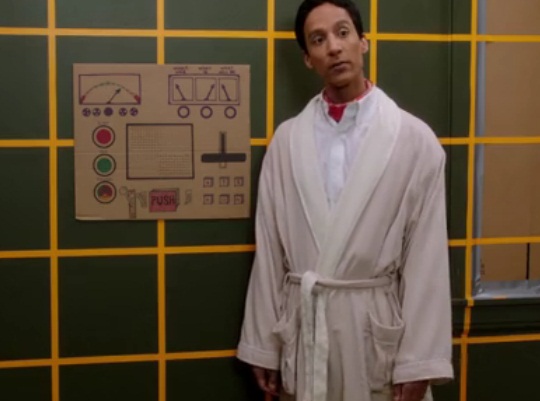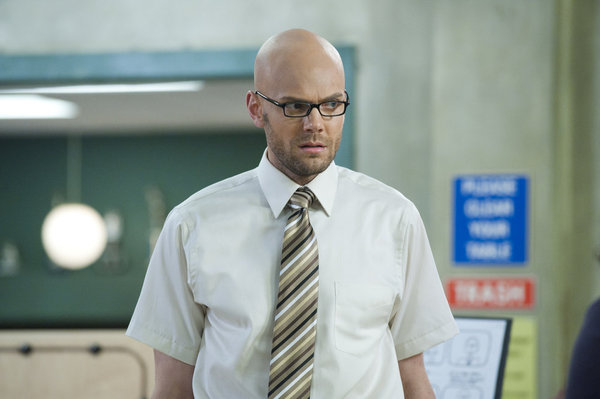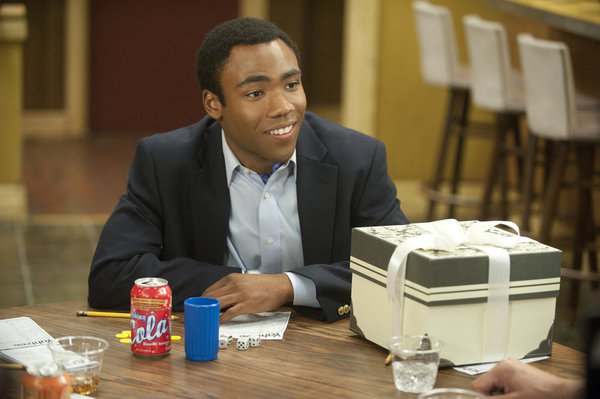 It was announced on Thursday night, following a particularly stellar episode of the series, that Community is being renewed for a fourth season on NBC. After a few celebratory rounds on the secret trampoline (no double bouncing), Greendale fans might have stumbled upon a particularly unsettling piece of news: creator and showrunner Dan Harmon might not be returning for Season 4. At this point, this is only speculation, reported originally by Deadline — Harmon’s cryptic Tweet only adds to the mystery. But even the slightest hint at the creator’s absence during Community‘s forthcoming season sparks dread in the hearts of fans. The simple fact is that Community cannot and should not continue on without Harmon at the wheel.
It was announced on Thursday night, following a particularly stellar episode of the series, that Community is being renewed for a fourth season on NBC. After a few celebratory rounds on the secret trampoline (no double bouncing), Greendale fans might have stumbled upon a particularly unsettling piece of news: creator and showrunner Dan Harmon might not be returning for Season 4. At this point, this is only speculation, reported originally by Deadline — Harmon’s cryptic Tweet only adds to the mystery. But even the slightest hint at the creator’s absence during Community‘s forthcoming season sparks dread in the hearts of fans. The simple fact is that Community cannot and should not continue on without Harmon at the wheel.
The man who came up with the Greendale universe, inspired by his own experiences forming unexpected friendships while attending community college in adulthood, is one of the few figures in show business who has vocalized such a profound, intricate and passionate love and appreciation for and knowledge of the very special, unique art form/family member that is television.
Those out there who have fallen in love with the show has recognized it as not only the best program on TV, but also the best program about TV. With its genre parodies and its deconstruction of sitcom staples, Community has served not just as a piece of unparalleled entertainment, but also as an invigorating academic lesson in the craft and history of the structure of the TV show. Without Harmon at the helm, these themes could not have existed so perfectly, nor could the fan favorite episodes that have embodied them.
“Investigative Journalism”
This might not be the best one to start with, as it is neither one of Community‘s most celebrated nor most memorable episodes, but it might well be one of the most important episodes in the history of the series. Best remembered as the Jack Black episode, this is the episode where Community went from being a show about seven misfits banding together, to a show about a show about seven misfits banding together. Black’s character Buddy (around whom Spanish studyin’ is allegedly better) represented the viewing public. Not the viewing public of Community, necessarily, but of all its codependency-themed sitcom predecessors.
This episode acknowledged the relationship that audiences have with shows like Friends — they’re not just half-hours of entertainment, they’re communities that fans wish to be apart of. But, just as Buddy couldn’t be welcomed into the study group, fans can’t be welcomed into the worlds of their favorite shows. These perfect worlds of perfect groups of people that you’d never find beyond the confines of your TV screen. This episode not only painted an articulate picture of television’s relationship with its viewers, it also started the study group on their path towards, and then violently away from, that image of “the perfect group.” All this must come from a close, personal relationship with TV. The kind of relationship that Harmon has expressed throughout his career.
On the audio commentary for Community‘s Season 2 DVD, Harmon makes mention that “Cooperative Calligraphy” might be the episode he would choose as a standalone representation of what Community is about. One of the first real gems of the second season, “Calligraphy” features an ostensibly simple plot surrounding seven people searching for a misplaced pen, which manifests as an examination of both interpersonal relationships as well as one of television’s most prominent staples: the bottle episode.
This episode proved Harmon to be not only emotionally attached to television, but also imbued with a deep understanding of the way it works and is meant to work (two things that don’t always go hand in hand). With Abed as the audience surrogate (as usual), understanding the televisual nature of the antics going on in the study room, the episode managed to illustrate the purpose and effectiveness of the bottle episode trope that has been used by television shows from The Honeymooners to Breaking Bad.

Not only can Dan Harmon analyze and cleverly illustrate a definition of any film/television genre, he can identify several definitions of the same genre. On the surface, the Community episodes “Intermediate Documentary Filmmaking,” “Documentary Filmmaking Redux,“ and “Blankets and Pillows” might all seem to be playing with the same tropes. But Harmon takes a look at the art of the documentary in the various ways it is used, and the significance of these uses: on television shows like Modern Family and The Office to more easily highlight the thoughts and emotions of its characters, in films like Hearts of Darkness, wherein humanity is sacrificed for art, and on Ken Burns specials to chronicle a particular historical event. Where it otherwise would have felt like a repetitive rehashing, Harmon delivers three unique, independently strong, emotionally poignant episodes.
The Clip Show Episodes
Again, Harmon uses the same trope in two very different, equally enthralling ways. In Season 2, the show totally broke the clip show trope by creating an episode consisting of clips with all new footage: “Paradigms of Human Memory.“ Whereas clip shows have traditionally been used as cheap ways of filling a half-hour of airtime, Community pioneered task of actually creating new stories, building a stronger (and kookier) history, and simply celebrating the presence of the show and the characters on it. The most recent episode, enigmatically titled “Curriculum Unavailable” uses the same tool, but in a different way. Whereas “Paradigms” introduced the viewers to new memories, “Curriculum” introduced the characters to a new perspective on their own old memories.
Credited as one of the best episodes in Community‘s three-year run, the “alternate timelines” episode demanded two very unique characteristics from its show runner: a heartfelt knowledge of and appreciation for science fiction, and a heartfelt knowledge of and appreciation for each of the seven main characters on the show. When it comes to shows of sitcom past, it’s generally a “what you see is what you get” situation. With Community, especially after “Remedial Chaos Theory,” it is abundantly clear that each character is intricately made up, and is unique in what he or she contributes to the show and the group’s dynamic (both as a group of people on a TV program, and as a group of people existing in a reality). Harmon loves all seven of these people to their very core, and gave his audience a chance to actually see what those cores consist of, in the most vivid way yet.
Abed
And while Community does exist as a show with seven very important, very well constructed characters, there is a hero among the bunch: Abed. Abed is Community‘s shining star. Community is Abed’s show. And from the moment we meet him in the pilot, to his first tear-jerking short film that touched his father’s heart, to his expressed reliance on television later in the first season, all the way up to his most recent post-expulsion breakdown into Inspector Spacetime mode (the only way he’s comfortable “getting to the bottom” of the very clear problem presented with he and his friends). And although Abed is awesome — a fly too awesome for the wall, in fact — he’s also a very complicated, very troubled, very lonely character. Dan Harmon appreciates this. He gave fans the heartbreaking “Abed’s Uncontrollable Christmas,” an animated episode that will make you break down in tears. He created the how-the-hell-did-this-get-approved “Critical Film Studies” in which Abed manipulates Jeff into inadvertently living out the movie My Dinner with Andre, the only way he knows how to reach out for human affection. And in “Virtual Systems Analysis,“ Abed takes a long, hard look at himself, realizing just how pained he his by his own compulsion to distance himself from his friends, and how much he needs them. Harmon loves Abed. He appreciates what makes him a tragic character. He also appreciates what makes him a hilarious oddball. And this balance is integral to keeping Community‘s most important figure as close to our hearts as he needs to be. Because, in all truth, most of us watching Community are Abeds in our own right.
More:
Community Recap: Curriculum Unavailable



